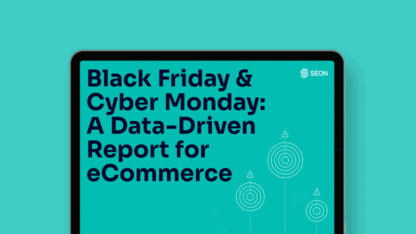With fraud losses estimated to cost global businesses billions annually, the need for effective fraud prevention strategies has never been more critical. On August 21, industry experts and peers gathered for a webinar co-hosted by SEON and the Merchant Risk Council, a global membership organization that focuses on eCommerce fraud prevention, payments optimization and risk management. The webinar discussed the limitations of traditional fraud prevention methods and the necessity of adopting a more proactive, technology-driven approach.
Moderated by George Pace, Senior PMM at SEON, and featuring panelists Chintan Sanghavi, Sr. Partner Solutions Architect at AWS; Mason Wilder, Research Director at ACFE; Vesna Petric, Consumer Fraud Analyst at Mollie; and Daniel Sebes, Director of Strategic Growth at SEON, the conversation provided valuable insights into the evolving fraud landscape and strategies companies can prioritize to stay ahead of today’s sophisticated fraudsters.
Top Insights From the Discussion Include:
1. Fraud Risks Are at an All-Time High
The current fraud landscape is more perilous than ever. With the rise of digital transactions, the proliferation of personal data, and the increasing sophistication of fraudsters, organizations face unprecedented levels of fraud risk. It’s crucial for companies to recognize the severity of the threat and take comprehensive measures to protect themselves.
“Fraudsters tend to exploit the fact that it’s really difficult for companies to move quickly. They are small, highly motivated, and skilled, making them more agile than larger enterprises.”
– Daniel Sebes
2. No Single Solution Stops All Fraud
Fraud isn’t any single moment in time. Instead, it presents complex challenges that require multifaceted and agile solutions. To the chagrin of many, there will never be one way, an anti-fraud ‘silver bullet’ that effectively addresses all the risks. As such, each organization must tailor its prevention strategies to meet its unique risk profile, including its specific threats and the operational realities it contends with. As fraudsters continue to innovate and find new ways to exploit vulnerabilities, the need for customized solutions is becoming more critical than ever.
“Each organization is different; some don’t even want to discuss fraud. Even very similar organizations in the same industry will have different risk profiles because of differences in operations and anti-fraud programs.”
– Mason Wilder
3. Continuous Monitoring Is Key
Companies can no longer rely on periodic audits or manual reviews to detect fraud; they must implement real-time monitoring systems. From activity and event monitoring to transaction monitoring and the detection of money laundering, the velocity and speed of fraudsters today necessitate effective tactics that operate without a lag. Continuous monitoring allows companies to stay vigilant and responsive, reducing the time it takes to detect and mitigate fraud.
“Fraud moves fast, and to drop a cliché, it’s kind of like trying to hit a moving target. You can’t just press or install a particular program and then walk away from it and expect to be totally covered – it requires continuous monitoring and adaptation to stay ahead of emerging threats.”
– Mason Wilder
4. Speed Is Critical in Prevention
Relying on outdated data, lengthy training cycles and other outmoded anti-fraud measures renders organizations vulnerable to rapidly changing fraud schemes. As fraudsters constantly evolve their tactics – with massive boosts from artificial intelligence (AI), machine learning and the popular Fraud-as-a-Service (FaaS) market – companies must adapt quickly. The time it takes to detect and respond to fraud can mean the difference between preventing significant losses and suffering substantial damage. Implementing tools and processes that enable swift action is critical to minimizing the impact of fraud on any business.
“Fraudsters are using ML algorithms to generate synthetic identities by combining real and fictitious personal information, making it harder to detect these fake identities. AI systems mimic human behavior and bypass security measures, allowing fraudsters to gain unauthorized access to accounts and take harmful actions.”
– Chintan Sanghavi
5. It’s a Friction Balancing Act
While speed is crucial, as explored above, it must be balanced against the need to minimize friction for legitimate customers. Implementing fewer barriers can lead to a better customer experience, which can drive customers away. Conversely, not having enough controls can leave an organization vulnerable to fraud. Striking the right (and often delicate) balance between speed and friction is critical in protecting a company and its customers.
“There are two main things that our merchants expect from us. On the one hand, they expect us to provide a level of security to prevent fraud when possible, but they also expect to see an increase in their conversions.”
– Vesna Petric
Moving from Reactive to Proactive
As the fraud landscape continues to evolve, organizations must be willing to challenge traditional approaches and embrace a more proactive, technology-driven mindset. By focusing on these key takeaways, businesses can strengthen their fraud prevention efforts and protect their bottom lines.
To speak with one of our experts, please reach out here.









